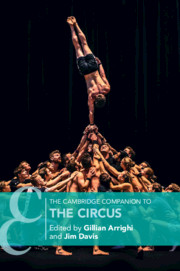Book contents
- The Cambridge Companion to the Circus
- Cambridge Companions to Theatre and Performance
- The Cambridge Companion to the Circus
- Copyright page
- Contents
- Figures
- Contributors
- Acknowledgements
- Timeline
- Introduction
- Part I Transnational Geographies of the Modern Circus
- Part II Circus Acts and Aesthetics
- Chapter 7 The Equestrian Circus
- Chapter 8 Animals, Circus, and War Re-enactment
- Chapter 9 Circus Clowns
- Chapter 10 Aerial Performance
- Part III Circus
- Part IV Circus Studies Scholarship
- Bibliography
- Index
- References
Chapter 7 - The Equestrian Circus
from Part II - Circus Acts and Aesthetics
Published online by Cambridge University Press: 22 June 2021
- The Cambridge Companion to the Circus
- Cambridge Companions to Theatre and Performance
- The Cambridge Companion to the Circus
- Copyright page
- Contents
- Figures
- Contributors
- Acknowledgements
- Timeline
- Introduction
- Part I Transnational Geographies of the Modern Circus
- Part II Circus Acts and Aesthetics
- Chapter 7 The Equestrian Circus
- Chapter 8 Animals, Circus, and War Re-enactment
- Chapter 9 Circus Clowns
- Chapter 10 Aerial Performance
- Part III Circus
- Part IV Circus Studies Scholarship
- Bibliography
- Index
- References
Summary
Equestrian acts were the foundation of the early circus and distinguished this new institution from other theatrical entertainments in the late eighteenth century. Although the advent of new circus has normalised an idea of an animal-free circus, the present century is enjoying a resurgence in performance with horses.Contemporary companies, such as Theatre Zingaro and Cavalia, present new narratives for a contemporary age, while performing acts with a long history. In this chapter Kim Baston considers the legacy of practices that continue to inform contemporary performance through the examination of specific case studies from the late eighteenth century to the present day. Examples include the Edinburgh Equestrian Circus as a representative example of acts in the early modern circus; Jenny de Rahden’s classic high school act of the nineteenth century; the trick riding of the Loyal-Repenskys, a large family troupe of the early twentieth century; the mid-twentieth-century liberty act by Yasmine Smart; and the contemporary equestrian company La Luna Caballera. This chapter provides a snapshot, as it were, of classic equestrian acts as they were performed at a particular historical moment, focusing on the conjunction of the repeated skills of the repertoire and their re-imagination in contemporary practice.
Keywords
- Type
- Chapter
- Information
- The Cambridge Companion to the Circus , pp. 107 - 126Publisher: Cambridge University PressPrint publication year: 2021



